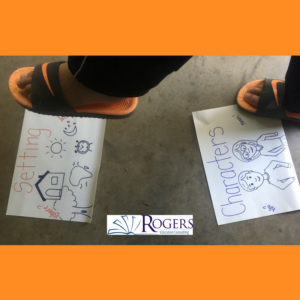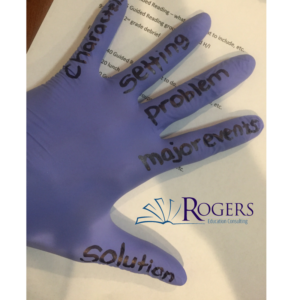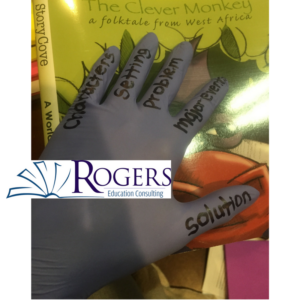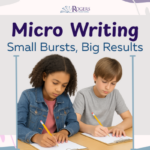** Contact us if you would like Rogers Education Consulting to come to your campus with engaging, evidence-based, practical professional development **
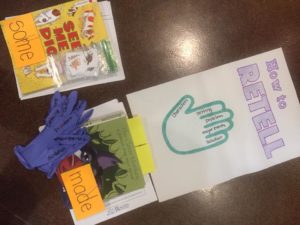 For the past year, a number of districts I work with have identified reading comprehension as a target for improvement, and so I have been supporting them through explicit instruction, Guided Reading, and Readers’ Workshop. As I work with a wide variety of classrooms, one conclusion I have drawn is that one reading strategy that is quite underutilized is having students retell the stories they are reading! Retelling is an active strategy that requires students to know how stories work and it requires the ability to determine the importance of and sequence events. When students retell texts, it results in increased and deeper comprehension, as well as retention of story events.
For the past year, a number of districts I work with have identified reading comprehension as a target for improvement, and so I have been supporting them through explicit instruction, Guided Reading, and Readers’ Workshop. As I work with a wide variety of classrooms, one conclusion I have drawn is that one reading strategy that is quite underutilized is having students retell the stories they are reading! Retelling is an active strategy that requires students to know how stories work and it requires the ability to determine the importance of and sequence events. When students retell texts, it results in increased and deeper comprehension, as well as retention of story events.
Retelling is also the stepping stone to summarization. Before we can expect students to summarize, they have to be able to retell. When we are talking about retelling fiction stories, this flexible strategy should grow with the student’s reading confidence and readiness level.
 For emergent readers, retelling should be mostly about sequencing events. These students should also be given scaffolds to retell the story. Since they are emergent readers, I make sure that the scaffolds are mostly pictures. Give students a scaffold with three or four columns and have them point to the column as they retell the story. The picture example here is one I used with a book called, Pig Has a Plan. In our Guided Reading group, the students and I talked about what happened in the book. Then we used the scaffold to retell the story in order. We pointed to the pig first and then moved our finger across the strip of paper and said, “Pig really wanted to take a nap, but his friends were making too much noise so he hid under the mud. Then he realized they were throwing him a birthday party.”
For emergent readers, retelling should be mostly about sequencing events. These students should also be given scaffolds to retell the story. Since they are emergent readers, I make sure that the scaffolds are mostly pictures. Give students a scaffold with three or four columns and have them point to the column as they retell the story. The picture example here is one I used with a book called, Pig Has a Plan. In our Guided Reading group, the students and I talked about what happened in the book. Then we used the scaffold to retell the story in order. We pointed to the pig first and then moved our finger across the strip of paper and said, “Pig really wanted to take a nap, but his friends were making too much noise so he hid under the mud. Then he realized they were throwing him a birthday party.”
Another similar scaffold is to provide the students with pictures of the major events in the story. Have each student put the picture events in order. Then have them tell what happened in the story.
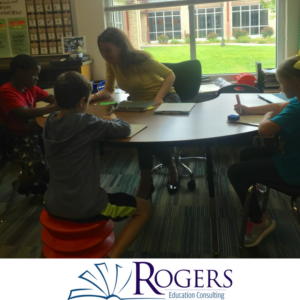 Early readers need to step up the retelling game a little bit. They should be able to talk about the beginning, middle, and end. Many times I hear this being taught as a way to summarize, but it’s really not all there is to summarization. It is, however, a great tool for retelling a story. Have students retell the story using sentence stems:
Early readers need to step up the retelling game a little bit. They should be able to talk about the beginning, middle, and end. Many times I hear this being taught as a way to summarize, but it’s really not all there is to summarization. It is, however, a great tool for retelling a story. Have students retell the story using sentence stems:
- In the beginning…
- Then in the middle …
- Finally, in the end …
If students need something a little more tactile, provide a rope with three big knots in it. Have students move their hand along the rope as they tell the three major parts of the story.
Another way early readers could be retelling stories is using the Somebody, Wanted, But, So method that is shared in When Kids Can’t Read (Beers). This is a great way to bridge the gap between the general “beginning, middle, and end” with having students retell the story elements, which is next!
Transitional readers need to up their retelling game. They should be retelling stories by discussing characters by name, the setting, major events of the story, the problem and the solution. To begin teaching this, I first make “floor mats” for each story element. I have the students “walk the story” by stepping on the mats and then sharing out loud the information about that element from the text they read. This is more of a whole group class exercise that gets the students thinking about what a problem is, what a solution is, etc.
In Guided Reading groups I give students a retell glove. This glove (latex and allergen-free) goes on their non-writing hand and has the “five finger retell” written on the glove. As they retell the story orally or write it down, their non-dominate hand has the parts of the retell to help them along. In our groups, we practice retelling the story a few times while we hold up our gloved fingers. Then they are ready to retell the story on their own, either orally or written.
How do you teach students to retell a story?
